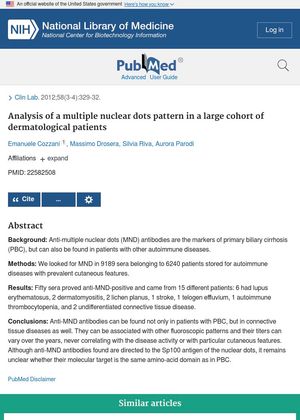Analysis of a Multiple Nuclear Dots Pattern in a Large Cohort of Dermatological Patients
January 2012
in “
PubMed
”

TLDR Anti-MND antibodies are present in various diseases, not just PBC, and their levels don't correlate with disease activity or skin symptoms.
In 2012, a study was conducted on 6240 patients to investigate the presence of anti-multiple nuclear dots (MND) antibodies, which are markers of primary biliary cirrhosis (PBC), but can also be found in patients with other autoimmune diseases. The study found that out of 9189 sera, 50 were anti-MND-positive and came from 15 different patients with various diseases including lupus erythematosus, dermatomyositis, lichen planus, stroke, telogen effluvium, autoimmune thrombocytopenia, and undifferentiated connective tissue disease. The study concluded that anti-MND antibodies can be found not only in patients with PBC, but in connective tissue diseases as well. However, their titers can vary over the years, never correlating with the disease activity or with particular cutaneous features. The molecular target of these antibodies remains unclear.

